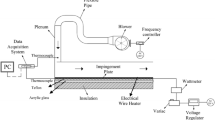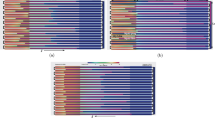Abstract
The present communication reports on the investigation of the effect of an electric field on the performance of a flat plate heat pipe (FPHP). In the studied configuration, an electric stress is imposed on the liquid–vapor interface, which adds to the capillary force. The ability of the electric field to change the shape of the liquid–vapor interface is investigated by means of both a numerical and an experimental approach. The numerical approach consists in solving two strongly-coupled equations: the Laplace–Young equation and the Laplace equation for the electric potential; the latter being required to get the distribution of the normal electric stress along the meniscus, while the former is used to calculate the meniscus shape. The Laplace–Youngequation is modified accordingly to take into account the added contribution of the normal electric stress. The results of the numerical study for an application inside an FPHP are discussed. A possible enhancement of the capillary pumping is highlighted for a specific geometry of the electrode. The experimental approach is based on a test bench that consists in a tilted grooved aluminum plate equipped with a pair of horizontal electrodes filled with Novec HFE-7100 in liquid and vapor states. The effect of the electric field on the liquid distribution is observed by confocal microscopy. A good agreement is found between the experimental result and the numerical expectations. The experimental results highlight important effects of the electric field on the liquid distribution inside an FPHP, which could be ultimately used to enhance its thermal performance.
Graphic abstract





















Similar content being viewed by others
Notes
Note that a compromise must be found because strongly non-wetting fluids are also known to degrade the thermal performance of FPHP.
Abbreviations
- e :
-
Unit vector
- E :
-
Electric field (V/m)
- F :
-
Electric force (N)
- FR:
-
Filling ratio (%)
- g :
-
Gravity acceleration (m2/s)
- G :
-
Gain (–)
- h :
-
Vapor spacing (m)
- K :
-
Groove permeability (m²)
- l eff :
-
Effective length of the groove (m)
- L c :
-
Capillary length (m)
- L v :
-
Latent heat of vaporization (J/kg)
- \(M_{\text{c}}\) :
-
Merite number (W/m²)
- P :
-
Pressure (Pa)
- Q :
-
Power (W)
- q :
-
Electric charge density (C/m3)
- r :
-
Radius of curvature (m)
- S :
-
Cross section (m²)
- T :
-
Temperature (K)
- V :
-
Potential (V)
- w :
-
Width of the groove (m)
- x :
-
Depth coordinate (m)
- y :
-
Horizontal coordinate (m)
- z :
-
Vertical coordinate (m)
- \(\alpha\) :
-
Apparent angle (°)
- \(\beta\) :
-
Inclination angle (°)
- \(\varepsilon\) :
-
Permittivity (F/m)
- \(\theta\) :
-
Contact angle (°)
- \(\kappa\) :
-
Curvature (m−1)
- \(\mu\) :
-
Dynamic viscosity (Pa/s)
- \(\rho\) :
-
Density (kg/m3)
- \(\sigma\) :
-
Surface tension (N/m)
- \(\sigma_{\text{E}}\) :
-
Electric conductivity (S/m)
- \(\tau\) :
-
Electric stress (N/m²)
- \(\phi\) :
-
Angle between the tangent at the interface and the horizontal (°)
- \({\text{Bo}}\) :
-
Bond number
- \({\text{Bo}}_{\text{E}}\) :
-
Electric bond number
- \(x^{*}\) :
-
Dimensionless parameter
- l:
-
Liquid
- n:
-
Normal component
- max:
-
Maximum
- t:
-
Tangentiel component
- v:
-
Vapor
References
Atten P (2012) Electrohydrodynamics of dispersed drops of conducting liquid: from drop deformation and interaction to emulsion evolution. In: International symposium on electrohydrodynamics. Gdansk, Poland
Bahadur V, Garimella SV (2008) Energy minimization-based analysis of electrowetting for microelectronics cooling applications. Microelectron J 39:957–965. https://doi.org/10.1016/j.mejo.2007.11.010
Bahadur V, Hale R (2019) Heat pipes with electrical pumping of condensate. US10168113B2
Bryan JE, Seyed-Yagoobi J (1997) Heat transport enhancement of monogroove heat pipe with electrohydrodynamic pumping. J Thermophys Heat Transf 11:454–460. https://doi.org/10.2514/2.6261
Cardin N, Davoust L, Lips S, Siedel S, Brik MEM, Bonjour J (2019) Effect of a DC electric field on a meniscus in a square groove. J Electrostat 100:103350. https://doi.org/10.1016/j.elstat.2019.05.002
Castellanos A (1998) Electrohydrodynamics, International Centre for Mechanical Sciences. Springer, Vienna
Chang H-C (2010) Electrokinetically driven microfluidics and nanofluidics. New-York, Cambridge
Chang FL, Hung YM (2017) Dielectric liquid pumping flow in optimally operated micro heat pipes. Int J Heat Mass Transf 108:257–270. https://doi.org/10.1016/j.ijheatmasstransfer.2016.12.018
Cheng J-T, Chen C-L (2010) Adaptive chip cooling using electrowetting on coplanar control electrodes. Nanoscale Microscale Thermophys Eng 14:63–74. https://doi.org/10.1080/15567261003601771
Cheng C-C, Chang CA, Yeh JA (2006) Variable focus dielectric liquid droplet lens. Opt Express 14:4101–4106. https://doi.org/10.1364/OE.14.004101
Cooper P (1990) EHD enhancement of nucleate boiling. J Heat Transf 112:458–464. https://doi.org/10.1115/1.2910400
Darabi J, Wang H (2005) Development of an electrohydrodynamic injection micropump and its potential application in pumping fluids in cryogenic cooling systems. J Microelectromech Syst 14:747–755. https://doi.org/10.1109/JMEMS.2005.845413
Davoust L, Fouillet Y, Malk R, Theisen J (2013) Coplanar electrowetting-induced stirring as a tool to manipulate biological samples in lubricated digital microfluidics. Impact of ambient phase on drop internal flow pattern. Biomicrofluidics 7:044104. https://doi.org/10.1063/1.4817006
De Gennes PG (1985) Wetting: statics and dynamics. Rev Mod Phys 57:827–863. https://doi.org/10.1103/RevModPhys.57.827
Diao YH, Liu Y, Zhang J, Guo L, Zhao YH, Wang S (2015) Effect of electric field on the enhanced heat transfer characteristic of an evaporator with multilayered sintered copper mesh. J Electrostat 73:26–32. https://doi.org/10.1016/j.elstat.2014.10.005
Dunn PD, Reay DA (1982) Heat Pipes. Pergamon Press, Oxford
Faghri A (1995) Heat pipe science and technology, 1st edn. Taylor & Francis, Washington, DC
Hallinan KP, Bhagat W, Kashaboina B, Kashani AR (1998) Electro-hydrodynamic augmentation of heat transport in micro heat pipe arrays. HTD Proc ASME 361(3):165–171
Jones TB (1973) Electrohydrodynamic heat pipes. Int J Heat Mass Transf 16:1045–1048. https://doi.org/10.1016/0017-9310(73)90043-4
Jones TB (2005) An electromechanical interpretation of electrowetting. J Micromech Microeng 15:1184–1187. https://doi.org/10.1088/0960-1317/15/6/008
Ko SH, Lee SJ, Kang KH (2009) A synthetic jet produced by electrowetting-driven bubble oscillations in aqueous solution. Appl Phys Lett 94:194102. https://doi.org/10.1063/1.3123165
Lallemand M, Lefèvre F (2004) Micro/mini heat pipes for the cooling of electronic devices. In: Proceedings of 13th international heat pipe conference. Shanghai, China
Lips S, Lefèvre F, Bonjour J (2010) Combined effects of the filling ratio and the vapour space thickness on the performance of a flat plate heat pipe. Int J Heat Mass Transf 53:694–702. https://doi.org/10.1016/j.ijheatmasstransfer.2009.10.022
Loehrke RI, Sebits DR (1975) Flat plate electrohydrodynamic heat pipe experiments. NASA STI/Recon Technical Report N 28370
Malk R, Fouillet Y, Davoust L (2009) Rotating flow within a droplet actuated with AC EWOD. Procedia Chem 1:1107–1110. https://doi.org/10.1016/j.proche.2009.07.276
Mancio Reis FM, Lavieille P, Miscevic M (2015) Toward enhancement of water vapour condensation using wettability gradient surface. Exp Thermal Fluid Sci 67:70–74. https://doi.org/10.1016/j.expthermflusci.2014.11.001
Mandal S, Chakraborty S (2017) Influence of interfacial viscosity on the dielectrophoresis of drops. Phys Fluids 29:052002. https://doi.org/10.1063/1.4982662
Melcher JR, Taylor GI (1969) Electrohydrodynamics: a review of the role of interfacial shear stresses. Annu Rev Fluid Mech 1:111–146. https://doi.org/10.1146/annurev.fl.01.010169.000551
Patel VK, Seyed Yagoobi J, Sinha-Ray S, Sinha-Ray S, Yarin A (2016) Electrohydrodynamic conduction pumping driven liquid film flow boiling on bare and nanofiber-enhanced surfaces. J Heat Transf 138:041501. https://doi.org/10.1115/1.4032021
Pellat H (1896) Électrostatique non fondée sur les lois de Coulomb. Forces agissant sur les diélectriques non électrisés. Journal de Physique Théorique et Appliquée 5:244–256. https://doi.org/10.1051/jphystap:018960050024401
Pollack MG, Fair RB, Shenderov AD (2000) Electrowetting-based actuation of liquid droplets for microfluidic applications. Appl Phys Lett 77:1725. https://doi.org/10.1063/1.1308534
Quan X, Gao M, Cheng P, Li J (2015) An experimental investigation of pool boiling heat transfer on smooth/rib surfaces under an electric field. Int J Heat Mass Transf 85:595–608. https://doi.org/10.1016/j.ijheatmasstransfer.2015.01.083
Saad I, Maalej S, Zaghdoudi MC (2017) Modeling of the EHD effects on hydrodynamics and heat transfer within a flat miniature heat pipe including axial capillary grooves. J Electrostat 85:61–78. https://doi.org/10.1016/j.elstat.2016.12.004
Saad I, Maalej S, Zaghdoudi MC (2020) Numerical study on an electrohydrodynamically driven axially grooved flat miniature heat pipe. J Thermophys Heat Transf 34:13–25. https://doi.org/10.2514/1.T5623
Saha SK, Ranjan H, Emani MS, Bharti AK (2020) Enhancement of two-phase flow using EHD technique. In: Electric fields, additives and simultaneous heat and mass transfer in heat transfer enhancement. Briefs in Applied Sciences and Technology. Springer, Cham. https://doi.org/10.1007/978-3-030-20773-1_3
Santra S, Mandal S, Chakraborty S (2018) Electrohydrodynamics of confined two-dimensional liquid droplets in uniform electric field. Phys Fluids 30:062003. https://doi.org/10.1063/1.5026450
Sharma RK, Ganesan P, Tyagi VV, Metselaar HSC, Sandaran SC (2015) Developments in organic solid–liquid phase change materials and their applications in thermal energy storage. Energy Convers Manag 95:193–228. https://doi.org/10.1016/j.enconman.2015.01.084
Shin WT, Yiacoumi S, Tsouris C (2004) Electric-field effects on interfaces: electrospray and electrocoalescence. Curr Opin Colloid Interface Sci 9:249–255. https://doi.org/10.1016/j.cocis.2004.06.006
Siedel S, Cioulachtjian S, Robinson AJ, Bonjour J (2011) Electric field effects during nucleate boiling from an artificial nucleation site. Exp Thermal Fluid Sci 35:762–771. https://doi.org/10.1016/j.expthermflusci.2010.06.006
Siva Kumar Gunda N, Bhattacharjee S, Mitra SK (2012) Study on the use of dielectrophoresis and electrothermal forces to produce on-chip micromixers and microconcentrators. Biomicrofluidics 6:034118. https://doi.org/10.1063/1.4749827
Suman B (2006) A steady state model and maximum heat transport capacity of an electrohydrodynamically augmented micro-grooved heat pipe. Int J Heat Mass Transf 49:3957–3967. https://doi.org/10.1016/j.ijheatmasstransfer.2006.04.011
Theisen J, Davoust L (2012) Dual-frequency electrowetting: application to drop evaporation gauging within a digital microsystem. Langmuir 28:1041–1048. https://doi.org/10.1021/la203645t
Theisen J, Davoust L (2015) Mass transfer enhancement and surface functionalization in digital microfluidics using AC electrowetting: the smaller, the better. Microfluid Nanofluid 18:1373–1389. https://doi.org/10.1007/s10404-014-1536-2
Yu Y, Hu X, Tang J, Zhou W (2019) Experimental study on EHD effects on wetting characteristics of liquid in open rectangular microgrooves. Appl Therm Eng 162:114178. https://doi.org/10.1016/j.applthermaleng.2019.114178
Acknowledgements
The Ph.D. fellowship of N. Cardin was supported by the energy ARC program of Rhône-Alpes region, which is gratefully acknowledged. The SIMaP laboratory is also part of the LabEx Tec21 (Investissements d’Avenir—Grant Agreement #ANR-11-LABX- 0030). The authors are grateful to the members of Institut des Nanotechnologies de Lyon (INL, UMR5270) who were involved in the fabrication of the ITO coatings, particularly Dr. Radoslaw Mazurczyk and Dr. Jean-Louis Leclercq who kindly offered an essential support to this research.
Author information
Authors and Affiliations
Corresponding author
Additional information
Publisher's Note
Springer Nature remains neutral with regard to jurisdictional claims in published maps and institutional affiliations.
Rights and permissions
About this article
Cite this article
Cardin, N., Lips, S., Siedel, S. et al. Two-phase electrohydrodynamics along a grooved flat heat pipe. Exp Fluids 61, 170 (2020). https://doi.org/10.1007/s00348-020-03002-9
Received:
Revised:
Accepted:
Published:
DOI: https://doi.org/10.1007/s00348-020-03002-9




